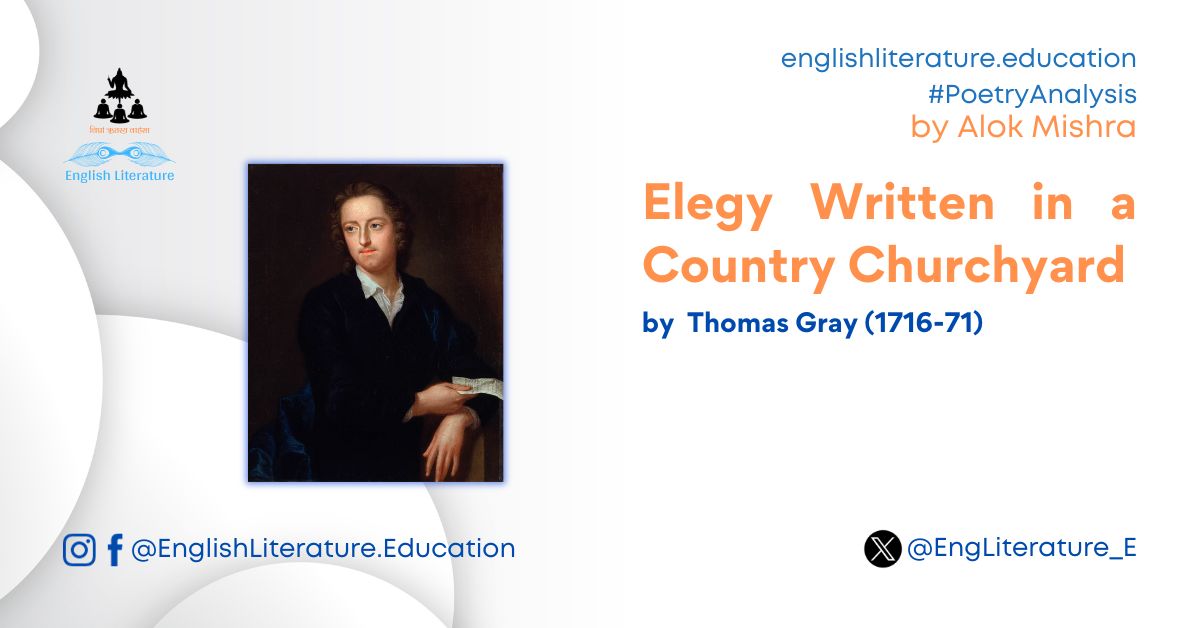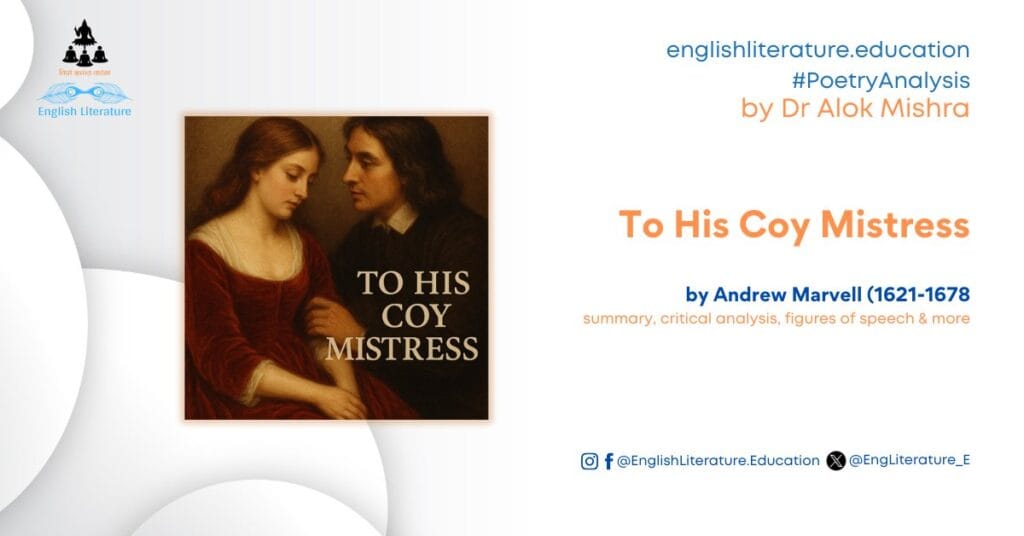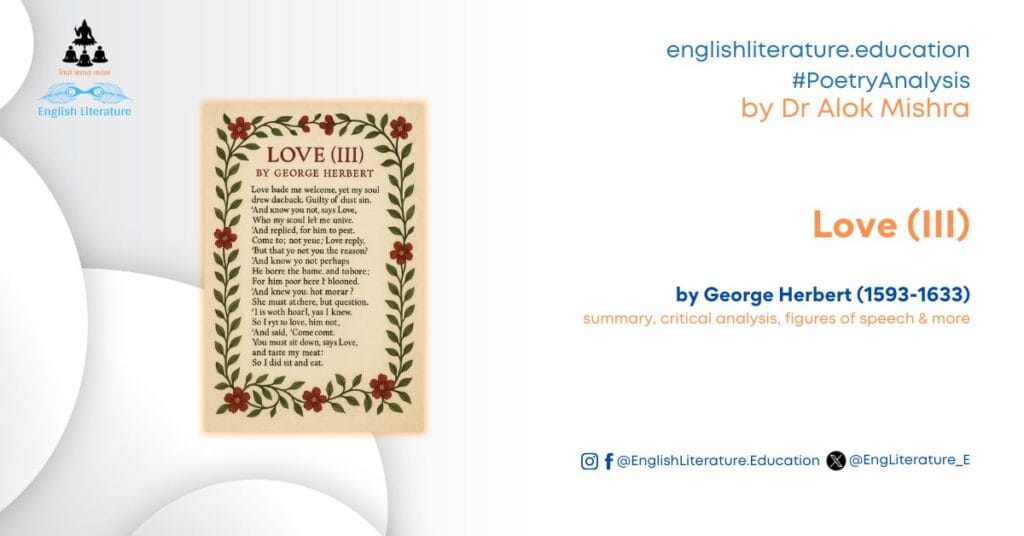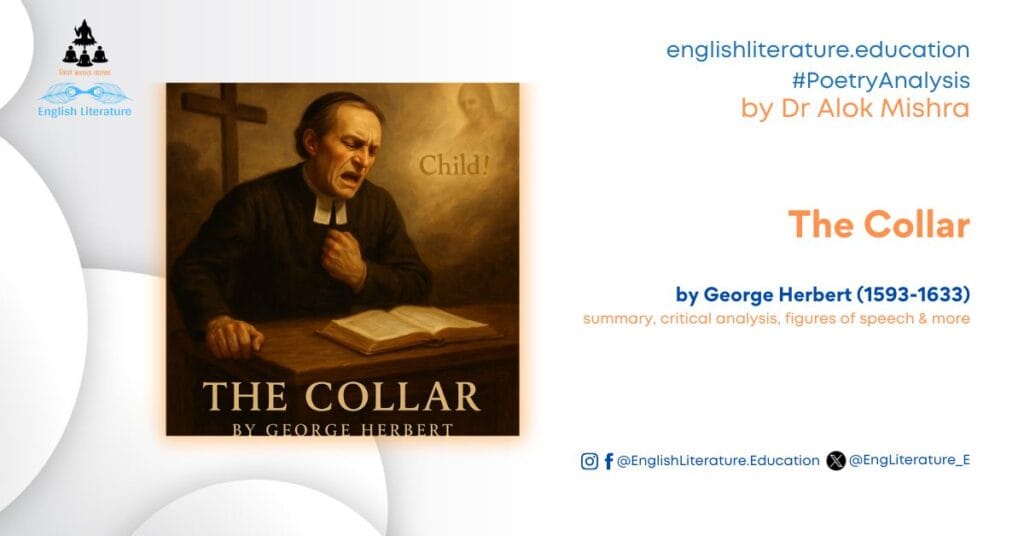Stanza 16-17-18
Stanza 19
In stanza 19 of Elegy Written in a Country Churchyard, Thomas Gray offers a serene and dignified summation of the villagers’ lives. He affirms that these individuals lived “Far from the madding crowd’s ignoble strife,” thereby situating them away from the chaos, ambition, and morally questionable pursuits of public life. The phrase “madding crowd” connotes a frenzied and morally degraded society, reinforcing the earlier contrast between the rural dead and the world of political and material aspiration.
Their “sober wishes never learn’d to stray” suggests a life of temperance and modesty, unmarred by excessive desires or dangerous ambitions. This restraint is further embodied in the image of the “cool sequester’d vale of life,” a metaphor for both their physical setting and their inward, unassuming existence. The “noiseless tenor of their way” highlights the quiet continuity of their daily lives, lives not marked by great upheavals or grandiose acts, but by a tranquil and morally unblemished persistence.
The stanza, in its compact quatrain and ABAB rhyme, encapsulates the essence of Gray’s elegiac tribute to the common man. It extols a form of spiritual and ethical fulfilment that stands apart from public recognition or worldly accomplishment. This moment of calm and reflective admiration serves as a tonal counterbalance to the previous stanzas that explored unrealised potential, affirming that peace and dignity can be found in obscurity.
Trivia: Thomas Hardy’s famous novel, Far from the Madding Crowd, gets its title from this very stazza.
..
Stanza 20
In stanza 20 of Elegy Written in a Country Churchyard, Thomas Gray continues his meditation on the lives of the rural dead by highlighting the human impulse to preserve dignity and memory even in death. He notes that “ev’n these bones,” referring to the simple villagers interred in the churchyard, deserve protection from “insult,” a term that may encompass neglect, desecration, or oblivion. The “frail memorial” alludes to the modest tombstones or markers that attempt to safeguard their legacy, no matter how humble or decayed.
These markers are adorned with “uncouth rhymes and shapeless sculpture,” which, while lacking refinement or artistic merit, are nevertheless sincere expressions of remembrance. Gray subtly elevates these “uncouth” elements by showing their emotional and cultural significance. They serve not to glorify but to humanise. The inscription “implores the passing tribute of a sigh” underscores the poignancy of the scene. These memorials do not demand grandeur; they merely seek a moment’s recognition from the living, a mere sigh that acknowledges a shared human fate.
Thus, the stanza gently reinforces the poem’s central theme: that even the obscure and humble deserve to be remembered. It also critiques the societal habit of reserving remembrance for the powerful while suggesting that moral worth and emotional resonance can reside in simplicity and anonymity.
..
Stanza 21
This stanza from Elegy Written in a Country Churchyard reflects Thomas Gray’s deep sympathy for the common folk and his reverence for the quiet dignity of their lives and deaths. He notes that the names and years of the deceased “spelt by th’ unletter’d muse” are often recorded with spelling errors or irregularities by those lacking formal education. Yet, this “unletter’d muse” stands as a poetic symbol of authenticity, sincerity, and emotional truth, unrefined by classical schooling but rich in heartfelt sentiment.
These crude inscriptions “supply” the role traditionally held by public fame and poetic elegy. In doing so, Gray elevates the memorials of ordinary people, suggesting that such humble records are no less worthy of reverence than the grand tributes accorded to the famous. Moreover, the stanza invokes a quiet moral power: “many a holy text around she strews,” referring to biblical verses or religious aphorisms engraved on the tombstones. These texts serve as lessons in mortality for the living, especially for the “rustic moralist,” or the reflective village dweller who contemplates life and death through the lens of faith and tradition.
Thus, the stanza not only celebrates the moral and spiritual education found in rural life but also subverts the conventional notion that greatness must be publicly recognised. It reiterates Gray’s central concern: the universal dignity of all human lives, regardless of status or renown.
..
Stanza 22
This poignant stanza from Thomas Gray’s Elegy Written in a Country Churchyard addresses the deeply human reluctance to part with life. It raises a reflective, almost rhetorical question: Who has ever yielded to the oblivion of death—“dumb Forgetfulness”—without a moment of hesitation or regret?
The phrase “pleasing anxious being” is rich with contradiction, suggesting that life is a blend of joy and worry, yet still profoundly valued. No one willingly leaves behind “the warm precincts of the cheerful day,” a metaphor for life’s vibrancy, community, and sensual richness, without casting at least “one longing, ling’ring look behind.” Gray here captures the universal human impulse to cling to existence, even in the face of inevitable mortality.
By evoking this quiet, inward struggle, the poet continues his exploration of death not as a cold abstraction but as a profoundly personal passage. The stanza adds a layer of emotional intimacy to the elegy, reinforcing the idea that even the humble and unknown cherish life just as deeply as the grand and celebrated. It is a meditation on how the desire for continuation, for memory, and significance transcends social class, echoing the poem’s enduring egalitarian spirit.
..
Stanza 23
In this profoundly tender stanza from Elegy Written in a Country Churchyard, Thomas Gray explores the human yearning for emotional connection even in the moment of death. The poet asserts that the “parting soul” leans upon “some fond breast,” suggesting that the dying person instinctively seeks solace in the affection of a loved one. The phrase “pious drops the closing eye requires” refers to the sacred, heartfelt tears that mourners shed at the deathbed, underscoring the dignity and spiritual significance of grief.
The third line, “Ev’n from the tomb the voice of Nature cries,” extends the poem’s meditation on mortality by asserting that the natural impulses for connection and remembrance do not end with death. Instead, they resonate even from beyond the grave. Gray’s use of “Nature” here is both universal and emotional; he implies that the instinct for love, remembrance, and legacy is inherent to the human condition.
The final line, “Ev’n in our ashes live their wonted fires,” is especially powerful. It suggests that our passions, affections, and aspirations persist symbolically even after we pass away. Our remains are still imbued with the vitality that once animated us. Thus, Gray affirms the continuity of human feeling and the sacredness of remembrance, reinforcing the poem’s central theme: that every life, however humble, possesses enduring emotional and spiritual worth.
In these stanzas, Thomas Gray shifts the focus of Elegy Written in a Country Churchyard from the general meditation on death and obscurity to a more personal reflection, where the poet subtly anticipates his mortality and legacy. Addressing himself in the second person, “For thee, who mindful of th’ unhonour’d Dead,” Gray acknowledges his role as the sympathetic chronicler of the lives of the forgotten villagers. The phrase “artless tale” reinforces the simplicity and honesty of both their lives and his poetic tribute, devoid of ornate embellishment.
He imagines a future moment in which, guided by “lonely contemplation,” a kindred soul might wonder about the poet himself. The use of “some kindred spirit” suggests a like-minded individual, perhaps a reflective, sensitive person moved by the same quiet truths of life and death that inspired Gray’s elegy.
In response to this imagined inquiry, Gray conjures the voice of a “hoary-headed swain,” a wise old rustic villager, who recalls the poet’s familiar presence. The swain remembers him walking at dawn, “brushing with hasty steps the dews away,” a vivid pastoral image that captures the poet’s solitary nature and his communion with the quiet countryside. His morning ritual of greeting the sunrise on the “upland lawn” symbolises both poetic inspiration and spiritual awakening, framing him as a contemplative figure whose life, like those he mourns, was quietly noble and deeply attuned to the natural rhythms of life and death.
In this stanza, Thomas Gray offers a gentle, pastoral image of the poet, likely himself, at rest in the rural landscape he so dearly contemplates throughout the elegy. The setting is specific and vivid: “the foot of yonder nodding beech,” a tree marked by its aged and “fantastic” roots that coil and rise in unusual shapes, suggesting both age and natural grandeur. This detail lends an air of timelessness to the scene, linking the poet to the enduring presence of nature.
The phrase “His listless length at noontide would he stretch” paints a picture of the poet reclining in a relaxed, unhurried manner, reflecting the calm, indolent nature of rural life. This moment of repose indicates a surrender to contemplation, a deliberate withdrawal from the cares of the world. The use of “listless” suggests both languor and introspection rather than sloth, conveying a kind of meditative inactivity that fosters philosophical reflection.
The final line, “And pore upon the brook that babbles by,” captures the quiet communion between man and nature. The gentle sound of the brook offers a soothing accompaniment to the poet’s musings, while the act of “poring” implies thoughtful, even melancholic, engagement with the natural world. This stanza thus presents the poet not merely as an observer of rustic life but as one fully immersed in it, finding meaning and solace in its tranquil, uncelebrated beauty.
This stanza presents a more intimate and emotionally complex portrait of the poet, highlighting his inner turbulence in contrast to the serene landscape around him. The opening line, “Hard by yon wood, now smiling as in scorn,” juxtaposes the poet’s inner anguish with the apparent mockery of nature. The woodland, personified as “smiling,” seems to belittle or remain indifferent to human suffering, embodying nature’s impassive beauty amidst personal despair.
The poet is depicted as a solitary wanderer, “mutt’ring his wayward fancies,” suggesting that he is lost in introspective, perhaps disjointed, thought. This muttering reflects an inward dialogue, revealing both creative imagination and psychological unrest. The use of the word “wayward” implies deviation, not only from societal norms but possibly from rationality, underscoring his emotional vulnerability and intellectual isolation.
The third and fourth lines intensify this portrayal. The poet appears “drooping, woeful wan,” pale and sorrowful, akin to someone “forlorn” or abandoned. The similes—“like one forlorn, / Or craz’d with care, or cross’d in hopeless love”—place his melancholy within a broader human context of loss, mental strain, and emotional longing. Gray thus suggests that even a mind as contemplative and gifted as the poet’s is not immune to the agonies of love, despair, and solitude. The stanza as a whole evokes the archetype of the Romantic visionary, tortured by inner passion and alienated from worldly comforts, long before the Romantic movement itself fully emerged.
..
Stanza 28-29
These stanzas gently bring the poet’s imagined narrative to its quiet end, as told by the “hoary-headed swain,” or old shepherd, who has observed the speaker’s habits and disappearance. The transition from daily routine to death is handled with poignant subtlety, reflecting Thomas Gray’s overarching meditation on mortality and obscurity.
The first stanza begins with the shepherd’s moving yet straightforward observation: “One morn I miss’d him on the custom’d hill.” The choice of “custom’d” suggests how habitual the poet’s solitary walks had become, rendering his absence immediately noticeable. The progression, first one morning, then another, and still no sign of him “beside the rill,” “up the lawn,” or “at the wood,” evokes a quiet but powerful sense of foreboding. Each line reinforces the vanished presence of the speaker in places where he once communed with nature and contemplation.
The second stanza introduces the poet’s funeral. “The next with dirges due in sad array” signals the inevitable conclusion of the life just sketched. The use of the word “due” affirms a respectful farewell, even if modest. The phrase “slow thro’ the church-way path we saw him borne” connects his death with the setting of the entire elegy—the country churchyard—completing the imagined transition from observer of graves to one interred among them.
The final two lines invite the reader into the poet’s posthumous legacy. The call to “Approach and read (for thou canst read) the lay” is significant. It suggests that literacy, and thus remembrance, is not a universal phenomenon. The act of reading becomes a quiet act of preservation: of memory, reflection, and communion with the dead. The “stone beneath yon aged thorn” is not only a literal gravestone but a metaphor for the permanence of poetic memory and the natural integration of human life and death. With this, Gray elegantly leads into the epitaph, the concluding portion of the poem.
The Epitaph:
Alok Mishra for English Literature Education





7 Comments. Leave new
The second part has been added, guys.
Hope you enjoy the latest one as much as the previous one.
Best wishes,
Dr Alok M
Do share Part 2 of the article on the Elegy written….. Explanations of the remaining stanzas, critical commentary on the whole poem, and the conclusion.
On my first-ever encounter (I am 80) with this heartrending empathic poem, I sought to explore it myself before reaching out for academic insight! Thankyou, Alok. I dissolve into perplexity by Stanza 17, so please do continue to the end whenever you can.
Very soon, Howard!
I truly appreciate your enthusiasm for literature at this age. I wish you an even longer life and an increasing interest in literature.
Sir kindly provide us with the second part. These study modules have really been very helpful.
Regards
Good work! Thank you so much
I have a question, when are you going to publish part 2?
Very detailed and helpful. Thanks for giving the critical summary and analysis of the poem Elegy written in a country churchyard. Can you also give something for metaphysical poets?